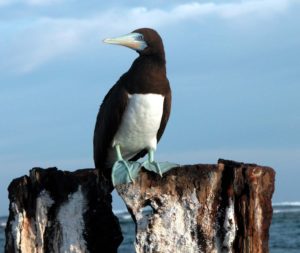
Brown boobies often rest on the rusting breakwater at Tern Island, French Frigate Shoals, Papahanaumokuakea Marine National Monument. ©Susan Scott
November 6, 2020
This week, I felt so sad and anxious over so many issues, that I decided to concentrate on two positive parts of my life that have an unlikely link: brown booby birds and charity.
This pleasant association came about because a friend recently made a generous donation to our free clinic in Bangladesh to help with the Covid-19 crisis there. In appreciation, I offered to make a mosaic wall hanging.
The family chose a bird, leaving the species up to me. Later, though, the dad mentioned that he enjoys the seabirds he sees gliding like gannets when he’s surfing on the North Shore.
Hawaii has no gannets, but we do have three species of their close relatives: red-footed booby, masked booby and brown booby. I knew which one Oakley meant, because Craig also admires them while surfing. After his frequent stand-up paddle excursions to Haleiwa’s navigation buoy, Craig comes back with a booby bird update. Last week, his report: “Fifteen browns on the buoy today!”
Brown boobies are nearly always on that buoy because these seabirds love to stand on stuff, be it a breakwater, a coconut, or a channel marker.
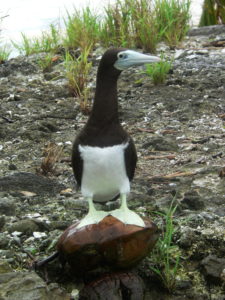
This brown booby gets some elevation on a coconut, Palmyra Atoll. ©Susan Scott
These seabirds also stand on anything floating on the water’s surface, including driftwood and sea turtles. The birds don’t perch as much as balance, their feet being more like swim fins, the wide, flat webs ideal for swimming.
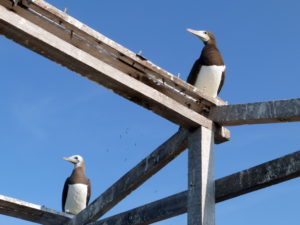
Two brown boobies in Mexico’s Isla Isabela, a protected island on the Pacific side. The bird in the lower left is a brown booby subspecies, called Brewster’s booby. Brewsters have lighter-colored heads and necks than browns. ©Susan Scott
Brown boobies are handsome in their brown-and-white tuxedos. The straight-line between the dark and white breast feathers across their chests make them easy to distinguish from the other two, which have solid white breasts.
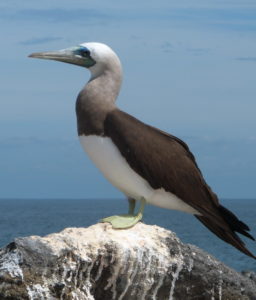
Brewsters brown booby, Isla Isabela. This pale subspecies is seen off Oahu and in the Northwest Hawaiian Islands but is less common here than its dark-brown cousin. ©Susan Scott
We see brown boobies flying over the ocean, looking for fish, in the main Hawaiian Islands, but most people will never see them nesting. Because they’re ground nesters, brown boobies are able to raise chicks only on islands absent of rats, cats, dogs, and mongooses.
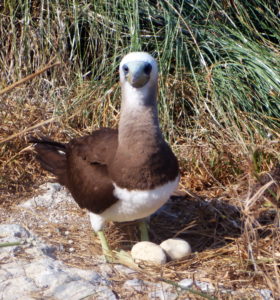
Brown boobies lay two eggs, but usually raise only one chick. The weaker one starves to death. This is a Brewster booby nest on Isla Isabela, an island that had a successful rat and cat eradication. It took two massive efforts. ©Susan Scott
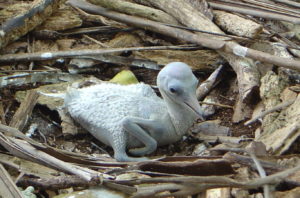
A newly hatched brown booby chick. We found only one egg, and later one chick, in this Palmyra Atoll nest. ©Susan Scott
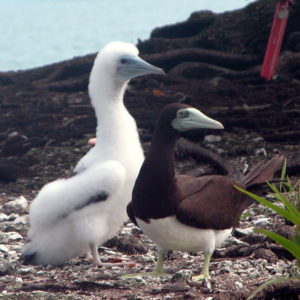
This chick towers over its parent, typical of booby birds. Palmyra Atoll. ©Susan Scott
Moku Manu off Kaneohe’s Marine Corps Base Hawaii, and Kaʻula Rock and Lehua Island, both off Niʻihau, are the few places in the main Hawaiian Islands hosting brown booby nests and chicks. The species is found worldwide, nesting in protected islands throughout the world’s tropical oceans.
The odd common name of these birds comes from bobo, a Spanish slang term meaning stupid. Spanish sailors thought the birds stupid because they evolved without predators, and were, therefore, easy to grab for a meal.
The Hawaiian name for all three of our booby birds is ‘Ā after the sound the bird makes. For some Hawaiian families, the brown booby is their ‘aumakua, or ancestral spirit.
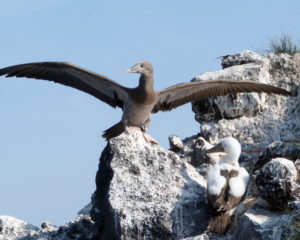
It takes 3 years for brown boobies to grow their trademark adult feathers, but they reach sexual maturity earlier. This young brown booby parent (below) feeds it chick. Isla Isabela. ©Susan Scott 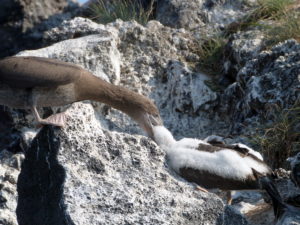
Oakley’s description of a gannetlike bird when seeing a brown booby is reasonable. The two are the same shape and members of the same seabird family. Gannets fly off Florida and New Zealand, both places Oakley has lived.
Some days the negatives our species has wrought–a divided nation, the pandemic, racism, global warming, plastic pollution, worldwide poverty–get to me and I feel awful. This week I fought that feeling by turning off all newscasts and taking long beach walks. That, of course, reminded me how lucky I am to live in Hawaii, where I can see, and help, native wildlife while raising money, with aloha, for people in need.
During these tense times, when there is so much talk is about winning and losing, a booby bird mosaic in exchange for a gift to our Bangladeshi friends is like breath of fresh air. Thanks Oakley, Destiny, Darius and Sparrow, for helping me get through this tough week.
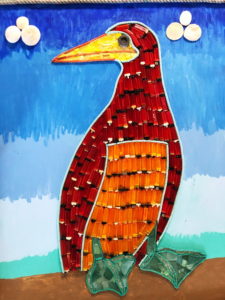
This is the brown-booby-work-in-progress I’m making for the Davis family. The cigarette lighters are from albatross nests on Midway Atoll. Feet are mostly broken glass floats from Kure Atoll. Blue, green and brown paint will be covered with plastic pieces and driftwood that my friends and I pick up from Oahu beaches. You can see finished mosaics and other marine debris pieces on the Art tab. See the Bangladesh tab for information about donating or volunteering to the Aloha Medical Mission.